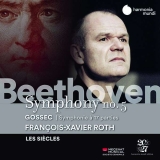 Ludwig van Beethoven: Symphonie Nr. 5; Francois-Joseph Gossec: Symphonie à 17 parties; Les Siècles, Francois-Xavier Roth; 1 CD Harmonia Mundi HMM 9024232019; Aufnahmen 2017/2020, Veröffentlichung 18/09/2020 (UK, F), 01/10/2020 (D) 54'39) - Rezension von Remy Franck
Ludwig van Beethoven: Symphonie Nr. 5; Francois-Joseph Gossec: Symphonie à 17 parties; Les Siècles, Francois-Xavier Roth; 1 CD Harmonia Mundi HMM 9024232019; Aufnahmen 2017/2020, Veröffentlichung 18/09/2020 (UK, F), 01/10/2020 (D) 54'39) - Rezension von Remy Franck

Als wolle er jede Schicksalsrhetorik vermeiden, dringt François-Xavier Roth in schneller Eile in die Fünfte Symphonie ein und dirigierte den ganzen ersten Satz flüssig und drängend. Für den zweiten Satz nimmt er sich mehr Zeit, pflegt die Kontraste zwischen dunklem Akzentuieren und agiler Beweglichkeit. Bedeutungsvoll und kräftig konturiert, mit auffallend virtuosen tiefen Streichern erklingt der dritte Satz, während das Finale recht konventionell daherkommt, sieht man einmal von den Qualitäten des auf historischem Instrumentarium saftig spielenden Orchesters ab. Und so hinterlässt Roths gute, aber (am Umfeld gemessen) nicht besonders charakteristische Fünfte nicht unbedingt einen bleibenden Eindruck, nicht zuletzt weil die Tonaufnahme an Klarheit und Präsenz das vermissen lässt, was man in Gossecs Symphonie findet.
Die 17-teilige Symphonie, die letzte dieses Komponisten, stammt aus dem Jahr 1809, wurde aber bereits 1792 skizziert und wird als musikalische Hommage an die Französische Revolution präsentiert, deren offizieller Komponist Gossec quasi war. Roth dirigiert das Werk zupackend und sehr souverän und ermutigt das Orchester, sehr elastisch und farbig zu spielen.
As if he wanted to avoid any rhetoric of fate, François-Xavier Roth rushes breathlessly into the Fifth Symphony and conducts the entire first movement fluently and urgently. He takes more time for the second movement, emphasizing the contrasts between dark accents and a very fine agility. The third movement is meaningful and powerfully contoured, with strikingly virtuosic low strings, while the finale is quite conventional, if one disregards the qualities of the orchestra, which plays lushly on historical instruments. And so, Roth’s good but (compared to other recordings) not particularly characteristic Fifth does not leave a really lasting impression, not least because the recording lacks in clarity and presence what we fortunately are able to experience in Gossec’s Symphony.
The 17-part Symphony, the last of this composer’s works, dates from 1809, but was sketched as early as 1792 and is presented as a musical homage to the French Revolution, of which Gossec was quasi the official composer. Roth’s interpretation is gripping, and he encourages the orchestra to play in a very flexible and colourful manner.
























